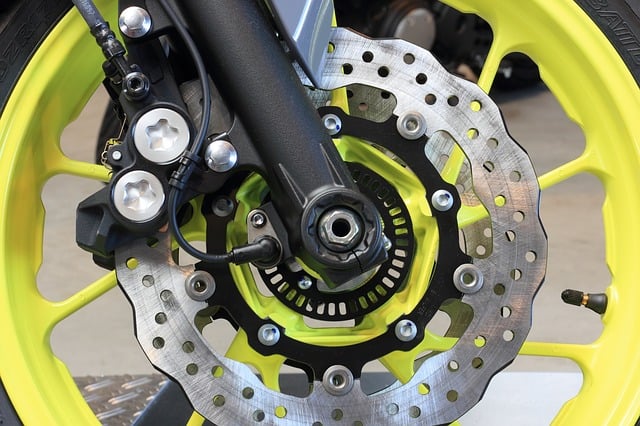Today’s motorcycles and cars are equipped with a very efficient braking system. They are so efficient that your vehicle stops safely, within a fraction of a second, in the case of an emergency. When you pull the brake lever, the brake fluid near the lever gets pressurized Via a brake line. This pressurized fluid connects to the brake pad at the wheel, and the brake pads are activated.
This braking system was developed over the last five decades of research and practical experience.
Let’s learn how engineers developed such an efficient braking system.
Or, more specifically, let’s learn the interesting physics behind disc brakes.
You might be wondering how the small force produced by your hand on the brake lever is sufficient enough to stop a motorcycle wheel?
Engineers achieved it by clever use of Pascal’s law. When you move the lever, a small piston also moves. The piston is oil-filled, so the oil is pressurized. If you check carefully, you can see that this piston is connected to a big piston via a cable.
In short, the big piston sits near to the brake pad, and the small piston sits near to the brake lever.
According to Pascal’s law, the pressure at both of the pistons should be equal. This means that the force you applied to the lever end will be multiplied many times at the brake pad end. Due to the difference in the area of the pistons.
This force will move the brake pad and press it against the brake disc. Thus, bringing the wheel to a stop.
The disc is directly connected to the wheel. To increase the area further. Generally, two pistons are used at the brake pad end. Another interesting thing you can observe about this mechanism is that pistons are there only on one side.
So, how does the brake pad on the other side move?
This is made possible due to a clever arrangement known as a Floating Caliper Mechanism. It should be noted, that the biggest part of this mechanism, the caliper, is not fixed. Rather it is free to move linearly. Caliper support is fixed to the motorcycle.
You can see in your vehicle how the caliper moves along this fixed part. This means as the pressure builds up in the cylinder, the floating caliper will also move opposite to the piston’s movement. The other brake shoe is directly attached to the floating caliper. So the braking action will happen from both sides simultaneously.
Due to the friction between the disk and the brake pads, a huge amount of heat is generated. And the disk gets extremely hot. In motorcycles, the discs temperature can be controlled because of the air circulation around it.
In cars, you need much higher air circulation and surface area for temperature control. Due to this reason, the discs of cars have veins inside them. The veins will help to throw the air radially outward. The holes around the disc further improve the air circulation.
The disc brake mechanism might seem like a simple mechanism. However, to understand how much disc brakes have helped in making automobiles safe. We must first learn about the predecessors of the disc brakes, drum brakes. Drum brakes ruled the automobile industry for many decades.
They are still used in the rear wheels of some cars. Their work was quite simple. The drum of this mechanism is directly connected to the wheels. When you apply the brake, a shoe pair inside the drum expands, and due to the frictional force, the wheel comes to a rest.
At first glance, this looks like an easy and perfect mechanism. However, drum brakes tend to overheat during braking. Due to the close nature of drum brakes, keeping them at or below, the optimum temperature is not an easy task.
Such overheating can lead to the expansion of the metal of the drum. And thus a reduction in the frictional force. In particular, a dangerous situation arises if one drum overheats, due to expansion of the metal, wear and tear, or a change in shape.
In this case, this wheel does not slow as fast due to the lower frictional force. The road to tire frictional force will also be lower here compared to, the other wheels on the axle.
These different frictional forces that occur will produce a net torque during the braking. And the whole car will spin because of this. This is why you will often notice that old cars that use only drum brakes will sometimes pull to the left or right during braking.
Such heating issue problems do not occur with disc brakes. Disc brakes also have better-stopping power compared to drum brakes. You might be surprised to know that most heavy-duty trucks still use drum brake technology.
The reason is simple. The drum brakes of trucks have huge metal parts, and these act as an efficient heat soak, saving the brake parts from overheating.
Disc brakes are also costlier than drum brakes, and thus, using disc brakes on heavy-duty trucks is not a good idea economically.
We hope this article provided you a great insight into disc brake technology. And please keep on supporting us.





